Photographs by the author, reproduced here by kind permission of the Chapter of Lichfield Cathedral. Click on them for larger images.
The Nave


The nave of Lichfield Cathedral (the Cathedral Church of the Blessed Virgin Mary and St Chad), Lichfield, Staffordshire. From 1857 onwards the Cathedral was restored by Sir George Gilbert Scott (1811-1878), and after his death the work continued under his son, John Oldrid Scott (1814-1913), until 1901. "As externally, so internally," says Nikolaus Pevsner, "the NAVE is all one build, and it is so drastically restored that it seems all Victorian" (182). Both pictures here show the length of the nave up to the crossing screen in front of the choir. The picture on the right gives the view towards the north aisle.
The Pulpit

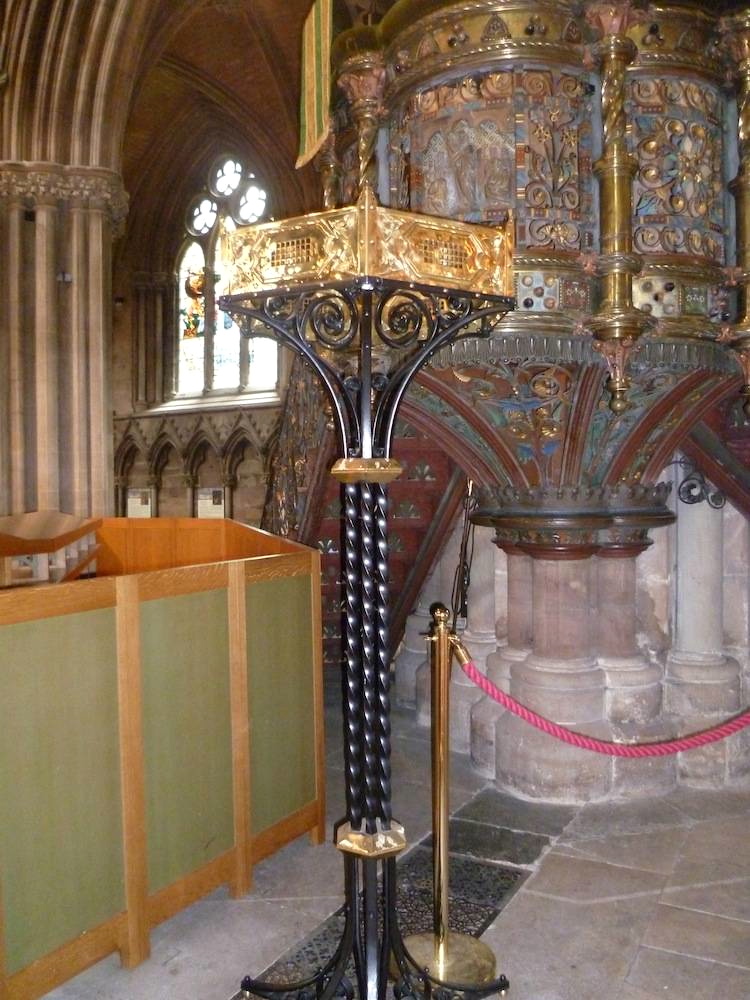
The pulpit, fixed to the pier at the western corner of the north transept, has two staircases. Pevsner writes, "By Scott or Skidmore" (186): it is likely to have been their usual collaborative effort. The rich mixture of materials, "wrought-iron, brass, copper, enamels, and marble" (Clifton 64), is just the kind that Francis Skidmore (1817-1896) loved. There is a brass relief in the middle, just under the lectern, showing St Peter preaching on the Day of Pentecost (again, Clifton 64). The eagle lectern above it was by John Hardman. The whole surround of the pulpit, as seen in the picture on the right, is elaborately and intricately ornamented.
The Font

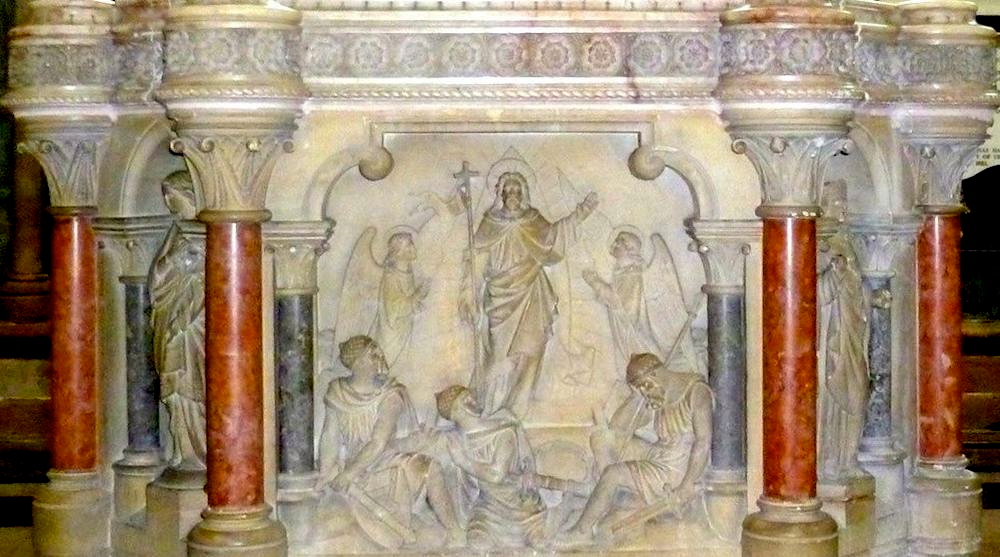
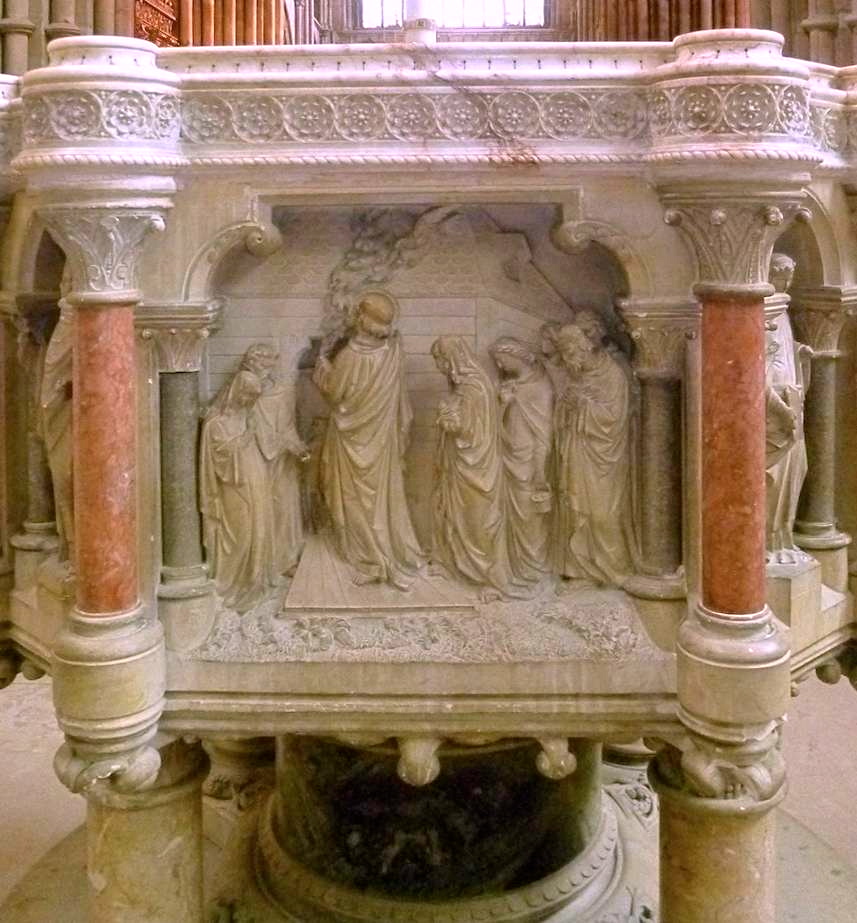
The font, made of Caen stone and alabaster with richly coloured marble pillars (see Clifton 63), is just inside the north transept. It dates from about 1862. "Ex-situ" here, as the listing text says, it has "early French Gothic detail and high relief scenes and figures." Three of the four scenes are shown above, left to right: the Exodus from Egypt with the Ark of the Covenant, with pyramids in the background and a camel's head appearing far right (near the top); the Resurrection (centre); and the entry to Noah's Ark, with the rump of an animal just going inside. Pat Scaife tells us that it is a cow (3). As she says, it is quite a humorous scene! A fourth scene, more predictably, shows Jesus being baptised. The figures between the scenes are of the Virgin Mary, St Peter, St Chad and St Helen. This elaborate font with its instructive Bible stories and appealing details was designed by William Slater (1819-1872) and executed by James Forsyth (1827-1910) (see Pevsner 186, Gifford et al. 707, and "James Forsyth").
The Crossing Screen
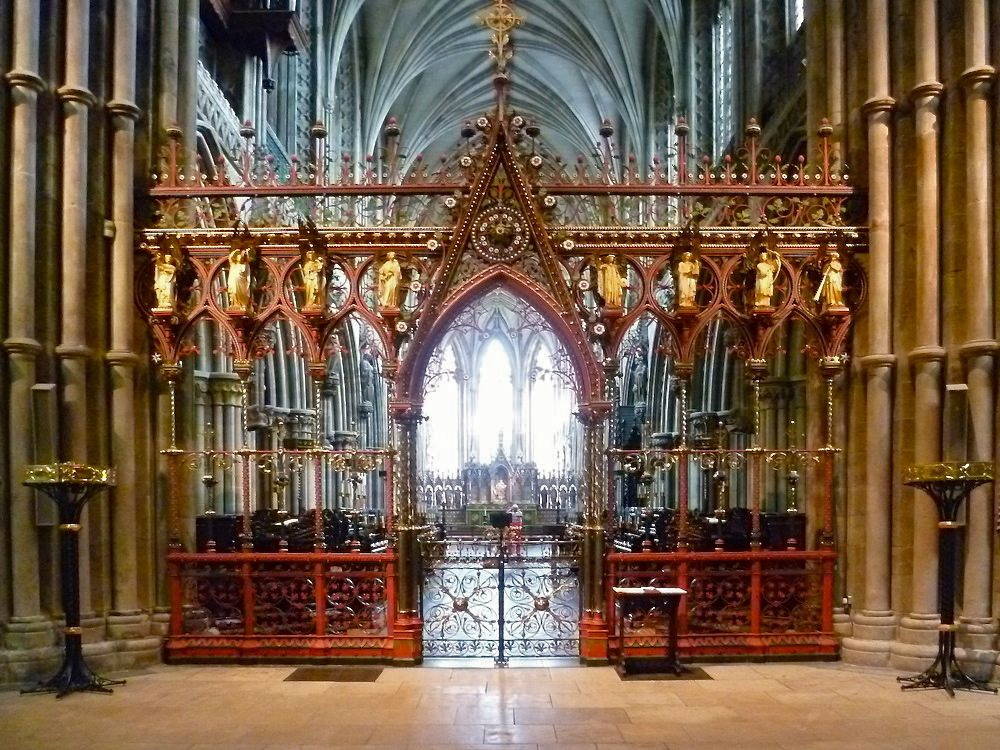
The crossing screen (1859-63) was designed by Scott and executed by Skidmore. Made of iron, brass and copper, it is one of the best fruits of their collaboration, and one of the chief glories of the cathedral: "Let Salisbury and Hereford be vandals and remove their Scott-Skidmore screens, Lichfield must hold out till High-Victorianism is at last fully appreciated in its best work" (Pevsner 186). Fortunately, that time has now come. NB, the Staffordshire book was the last of Pevsner's landmark series (see Foreword), and his own views on Victorianism had changed since the earlier days.
Scott himself, talking about progress made in metal-work in general, and his own contribution to it in particular, was quite modest — until it came to talking about these two screens:
My own individual share has not been great, excepting that I have had one or two great works carried out, such as the choir-screens at Lichfield and Hereford cathedrals. Both of these were designed in full by myself, and are carried out according to my designs, in general; in both, however, as in all his works, Mr. Skidmore has " kicked over the traces" wherever he has had a chance. In some cases the work has gained, and in some suffered from this. Original ideas have been imported, but a certain air of eccentricity has come in with them. On the whole the works are both very fine, and especially the latter. (216)
It would be nice to know why Scott gave the Hereford screen the edge here, but we do know that in his original design for the Lichfield one the central arched openings were less open (Noszlopy 225), and that he thought the final version changed the choir here from being "the closest of quires" to being "now the most open" (293). Perhaps he felt Skidmore had gone too far in this respect. Pevsner, however, appreciated this openness, and praised the screen for being "light and transparent," as well as for its high craftsmanship. As he says, it would be "an ornament to any cathedral" (186). One of its most attractive features is the row of eight angels at the top, playing musical instruments. They stand out from the metalwork because of their gilding, and make a splendid introduction to the Choir section.
The Choir: Wood-Carving
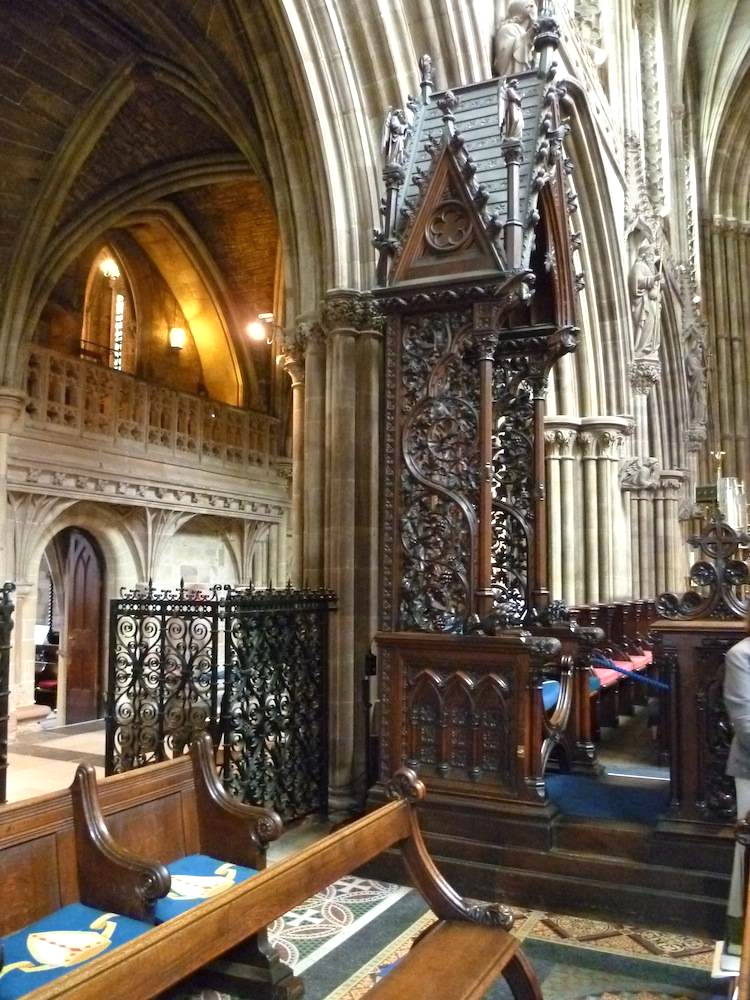

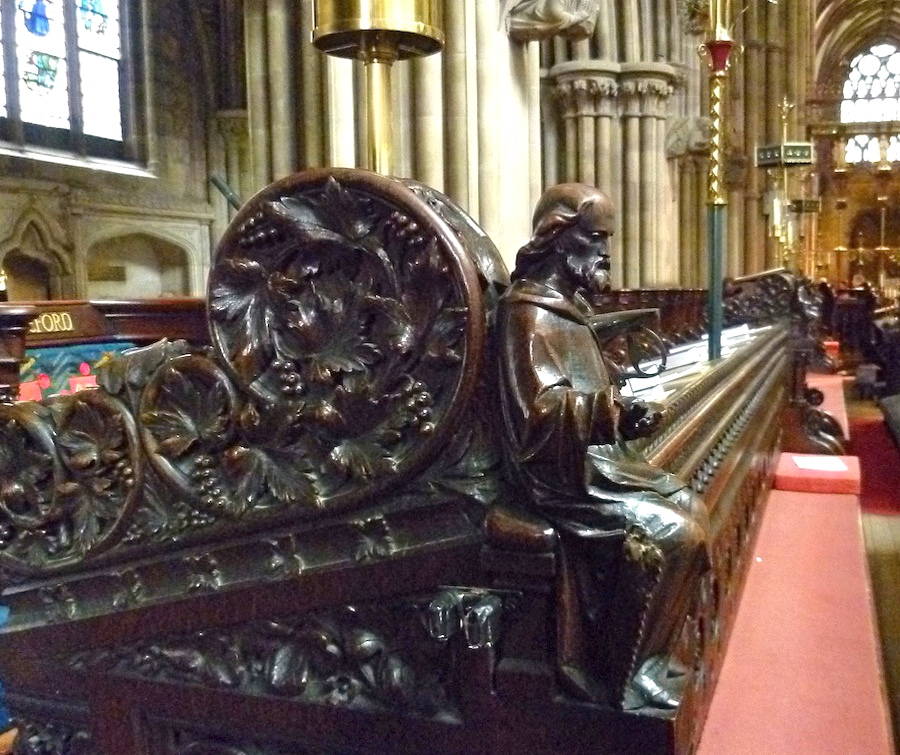
The Choir was the focus of Scott's work on the interior. There were "no old stalls remaining," he wrote (293), so he had to start afresh with this elaborately carved Bishop's throne and the new choir stalls, designing them himself. Scott was well aware of the literary connection here, noting that they were carved by William Evans of Ellastone, on the border with Derbyshire; Evans was George Eliot's uncle, and he had taken the family carpentry and building firm to new heights (see Mottram 61). Skidmore was likely to have been involved too, since some of the stalls have iron fronts (Pevsner 184). The statues in the choir, as in the Lady Chapel, were carved by the London firm of Farmer & Brindley. One or two are visible in the picture on the right.
The Choir and Chancel: Pavement and Reredos
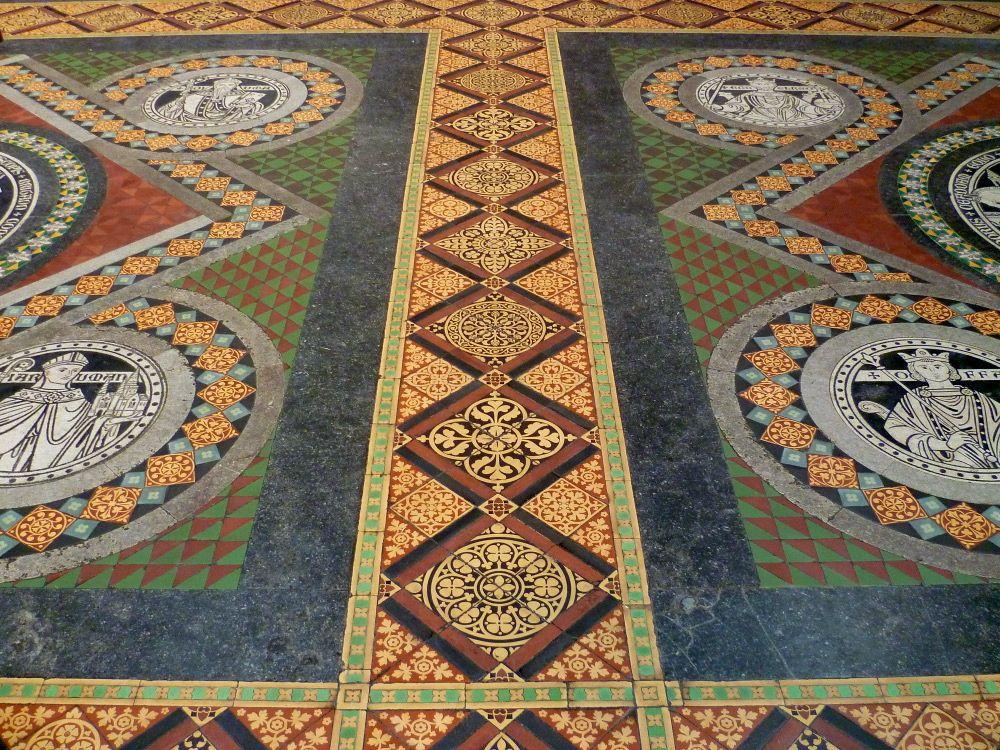

The very striking pavement of Minton tiles here was designed by the versatile Scott himself. Pevsner describes it as: "Stone, inlaid, medallions with scenes from the history of the diocese, also kings and bishops" (184-85). All the choir and chancel (more correctly, presbytery) fittings are quintessentially High Victorian neo-Gothic from the 1860s, with their climax in the "alabaster and coloured marble reredos and screen by Scott and Philip" (listing text). As this indicates, the reredos shown in the picture on the right was designed by Scott again, with the central panel (a relief of Jesus appearing to the disciples after the Resurrection), the statue of the Virgin Mary, angels, and the row of twelve figures of saints, all carved by John Birnie Philip in 1864 (Pevsner 184).
The Chapter House

Beautiful rib-vaulting with carved capitals and stone bosses in the Chapter House, coming down towards the shafted, deep-set traceried windows. A.B. Clifton writes:
There is a central pillar, the clustered shafts of which are banded in the centre; the capitals of these shafts have a particularly rich and elaborate carving of foliage; and above, the vaulting ribs spread to the roof like the branches of a tree, producing a very fine effect. The bosses where the ribs intersect are also worthy of attention, and the ribs rise from very richly-carved and deeply-moulded corbels. (111)
The Chapter House, as the windows' Y-tracery suggests, dates from around the mid-thirteenth century, and some important features remain from that time (see Scaife 5). But Scott was involved here too. Making it clear in his Personal and Professional Recollections that his work at Lichfield Cathedral "was mainly the opening out and rearrangement of the choir," he added: "The work has, at a later period, been extended to the Chapter-house and the Lady Chapel [which C. E. Kempe later re-ordered], and it is now contemplated to extend it to the exterior of the west front" (293). His work certainly did extend to other areas, particularly to the west front (see first link below). In the Chapter House, the crispness of some of the carving gives away the later work, but, in truth, it is not always possible to assess the contribution of each age or hand to each specific element of the Cathedral. Scott and his craftsmen were carrying on a long tradition and, unlike their predecessors, doing whatever they could to strengthen and preserve what remained of the past, while enriching it greatly in their own ways.
Related Material
- Exterior of the Cathedral
- Porch carvings by Mary Grant
- Lady Chapel
- Monument to Bishop Ryder (North Transept)
- Monument to Sir Charles Oakeley (North Transept)
- Monument to Bishop Selwyn (Lady Chapel)
- Monument to the "Sleeping Children" (South Choir Aisle)
- Monument to Dean Howard (South Choir Aisle)
- Monument to Archdeacon Hodson (South Choir Aisle)
- Monument to Major Hodson (South Choir Aisle)
- Monument to Andrew Newton (South Transept)
- Hacket window by C. E. Kempe
- Spode window by John Hardman
- "Faith, Hope and Charity" window by William Wailes
Sources
"The Cathedral Church of the Blessed Virgin Mary and St Chad, Lichfield." British Listed Buildings. Web. 26 June 2013.
Clifton, Arthur Benjamin. The Cathedral Church of Lichfield: A Description of Its Fabric and a Brief History of the Episcopal See London: George Bell, 1898. Internet Archive. Web. 26 June 2013.
Gifford, John, et al. The Buildings of Scotland: Edinburgh. Rev. ed. London: Penguin, 1991.
Greenslade, M. W. (ed.). "Lichfield: The Cathedral."' A History of the County of Stafford: Volume 14: Lichfield (1990): 47-57. Web. 26 June 2013.
"James Forsyth." Mapping the Practice and Profession of Sculpture in Britain and Ireland 1851-1951. Web. 26 June 2013.
Mottram, William. The True Story of George Eliot in Relation to "Adam Bede," Giving the Real Life History of the More Prominent Characters. Chicago: McClurg, 1906. Internet Archive. Web. 26 June 2013.
Noszlopy, George T., and Fiona Waterhouse. Public Sculpture of Staffordshire and the Black Country. Liverpool: Liverpool University Press, 2005. Print.
Pevsner, Nikolaus. The Buildings of England: Staffordshire. London: Penguin, 1974. Print
Scaife, Patricia. The Carvings of Lichfield Cathedral. Much Wenlock, Shropshire:R. J. L. Smith, 2010. Print.
Scott, Sir George Gilbert, R.A. Personal and Professional Recollections, edited by his son, G. Gilbert Scott, F.S.A. London: Sampson Low, Marston, Searle, & Rivington, 1879. Internet Archive. Web. 26 June 2013.
Welcome to Lichfield Cathedral. Short but informative guide available at the cathedral.
Last modified 26 June 2013